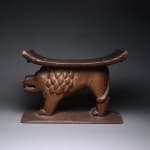Asante Wooded Stool Supported by a Lion, 20th Century CE
Further images
This magnificent zoomorphic stool was made by the Asante, one of the numerous tribes that make up the Akan polity of Ghana. It is an exceptional example. The general format...
This magnificent zoomorphic stool was made by the Asante, one of the numerous tribes that make up the Akan polity of Ghana. It is an exceptional example. The general format is traditional, with a flat base and a seat with upwardly-curved sides. The seat and base are separated by a snarling lion standing four-square, with a ruffed mane, open mouth and carefully picked-out facial features. The colour and patina are exceptional.
Stools such as this were used to assert status in many African tribal groups; only elites, and especially chiefs, were allowed to use them. Very often they were not sat upon, but were just displayed as regalia. This explains the often spindly and somewhat insubstantial construction of earlier examples. The various animals and humans that support the seat represent something of the ancestry of the stool's owner, or reflect his authority. The implications of the lion - a legendarily powerful beast - are obvious.
The Akan are a loose assemblage of tribes – including the Akuapem, the Akyem, the Ashanti, the Baoulé, the Anyi, the Brong, the Fante and the Nzema – that share general cultural trends while maintaining separate tribal identities. Their society is highly ritualised, with numerous gods under a main deity, Onyame. The society is ruled by Asantahenes, and a host of minor chiefs who claim royal status through their connection with the land and the founders of villages upon it. One factor that unites the Akan is the fact that they took a golden stool as their emblem and rose up against the European invaders in the 18th century. They have also staved off interest from Northern Islamic groups. The main reason for this imperial interest was the long history of gold mining and gold working in the area, which has been taking place for at least 600 years. As is apparent, they also manufactured regalia in other materials.
This stool would have been treated with the same reverence that a throne might attract in western European groups, as it was literally that important. From an aesthetic point of view, it is a striking and attractive piece of secular art, and a worthy addition to any collection or sophisticated domestic setting.
Stools such as this were used to assert status in many African tribal groups; only elites, and especially chiefs, were allowed to use them. Very often they were not sat upon, but were just displayed as regalia. This explains the often spindly and somewhat insubstantial construction of earlier examples. The various animals and humans that support the seat represent something of the ancestry of the stool's owner, or reflect his authority. The implications of the lion - a legendarily powerful beast - are obvious.
The Akan are a loose assemblage of tribes – including the Akuapem, the Akyem, the Ashanti, the Baoulé, the Anyi, the Brong, the Fante and the Nzema – that share general cultural trends while maintaining separate tribal identities. Their society is highly ritualised, with numerous gods under a main deity, Onyame. The society is ruled by Asantahenes, and a host of minor chiefs who claim royal status through their connection with the land and the founders of villages upon it. One factor that unites the Akan is the fact that they took a golden stool as their emblem and rose up against the European invaders in the 18th century. They have also staved off interest from Northern Islamic groups. The main reason for this imperial interest was the long history of gold mining and gold working in the area, which has been taking place for at least 600 years. As is apparent, they also manufactured regalia in other materials.
This stool would have been treated with the same reverence that a throne might attract in western European groups, as it was literally that important. From an aesthetic point of view, it is a striking and attractive piece of secular art, and a worthy addition to any collection or sophisticated domestic setting.







